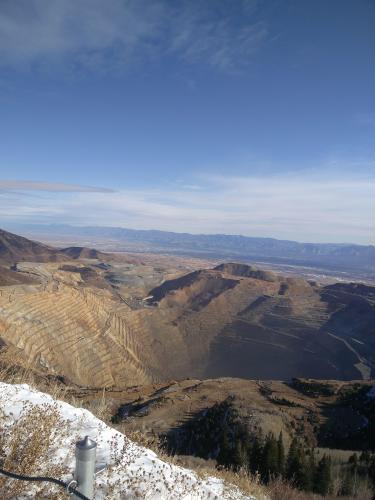Innocence [6]
Spiral Jetty is famously remote, if not as difficult to get to as some other land artworks. Smithson despised the art market, actively making work which, like the Jetty, refused to be commodified or easily gallerized. (Instead, it is photographed by other artists, who exhibit their photographs.) “Far away”ness is part of the Jetty’s aura. I have to wonder, “far away” from where—New York City? Paris? The center of the earth?
Driving along the sparsely inhabited rim of the Great Salt Lake on our way to see the Jetty, my friends and I pass a fence marked simply “ATK”. Behind the fence, rocket motors for space travel and weapons systems are tested. (I find this information on the internet later; there is no way to learn this on site.) Soon after, we pass the Golden Spike National Historic Site, where the east and west branches of the transcontinental railroad were joined in a glorified photo-op in 1869. The Golden Spike allowed railroad schedules to be synched and time zones standardized, the final intersection in the nation’s gridded network of precise minutes and hours. After passing the Historic Site, we turn onto a dirt road, so washed out I worry my sedan won’t survive the trip. After what feels like an hour of driving, we see the remnants of an abandoned oil rig and a large, crumbling concrete cylinder. Except for a sun-faded sign or two (“SPIRAL JETTY ⇨”) there is no fence, no gate, no ticket booth, and no museum guard that signals our arrival; nothing to draw a boundary between art and not-art. A few bone-rattling minutes later, the Jetty appears: small. That’s my first thought: small. By now I’d seen photographs of it in every weather and from every vantage point—images from its construction, its submersion beneath the lake, and its reemergence, glowing white with encrusted salt. We park and stare at it for a while.
A family arrives with a bundle of loud children, who immediately venture out on the Jetty. I can’t bring myself to walk on it yet, so I suggest we head the other direction and climb the hill behind us, winter taupe. There’s a ghost of a trail, more a scramble up gray-yellow grass and volcanic rock. We sit at the top. It looks better from up here; more like the pictures. Once the family leaves we huff down the slope, fighting gravity, and walk out on it. The lakebed is dry, so there’s no real danger of getting my shoes wet if I step off the Jetty onto the salt. Still, I feel slotted in, like an engine on rails. I move forward as if compelled. It feels strange, pausing to look around—out at the lake’s pyrotechnics, a distant storm opening to light; back at the shore, my dusty Hyundai; sideways toward an old oil derrick, small in the distance. I have a sentence to finish, or a chord to resolve, so I walk. When I reach the center of the spiral, I finally feel free to look up; only now I’m penned in. A friend hops the layers, running toward me across the dry lakebed to the black rocks making up the next rotation, skipping forward in the sequence. It feels like witnessing a transgression.

